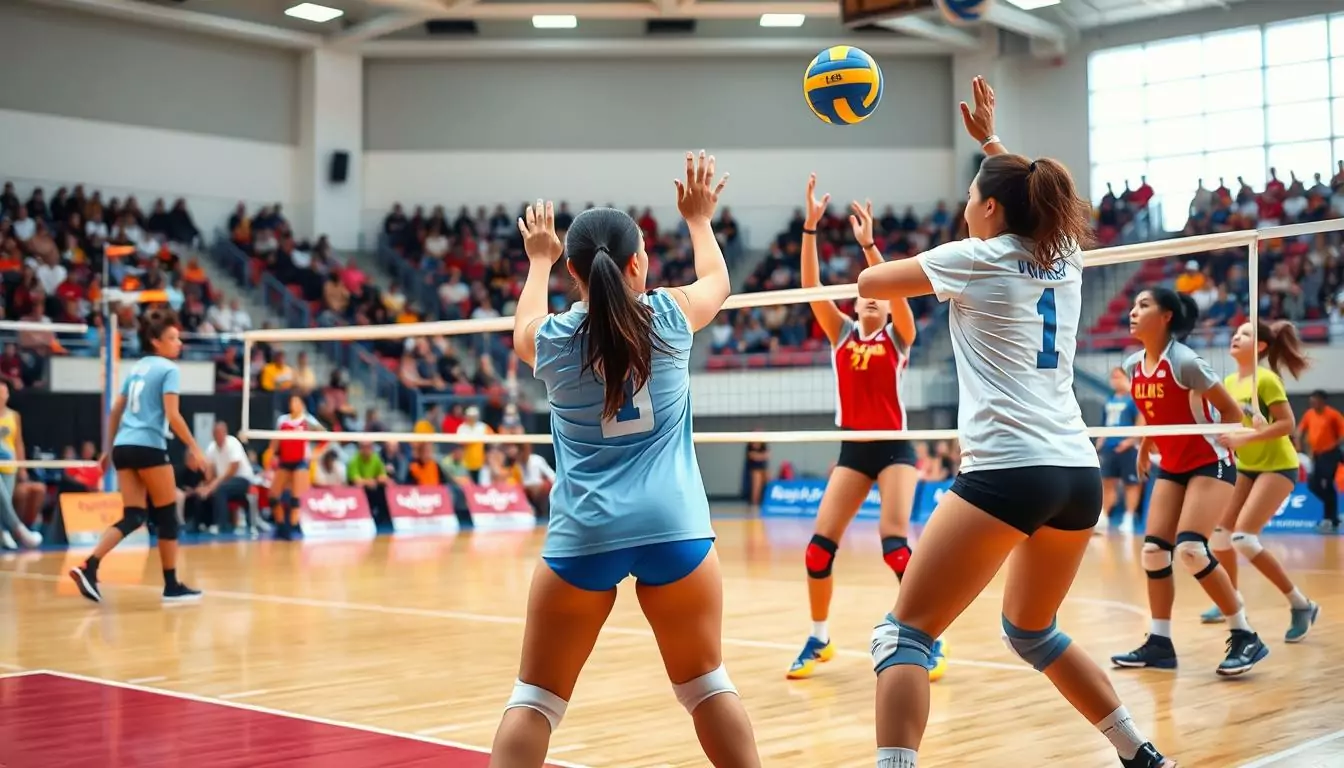Volleyball was created in 1895 by William G. Morgan. It has grown into a game with six main positions. Played on a 9m x 18m court, teams try to hit the ball over the net to score.
Knowing each position well is key for teamwork and strategy. Volleyball teams have 10 to 14 players. Coaches often aim for at least two players per position for substitutions.
Key Takeaways
- Volleyball has six main positions: setter, outside hitter, middle blocker, opposite hitter, libero, and defensive specialist.
- The setter is the player who touches the ball most frequently, running the team’s offense by setting the ball to attackers.
- Outside hitters and opposite hitters are the primary scoring threats, while middle blockers focus on defense and quick attacks.
- The libero is a specialized defensive player who can freely substitute in and out of the game.
- Understanding the court layout and the responsibilities of each position is key for effective teamwork and strategy.
What Are Volleyball Positions?
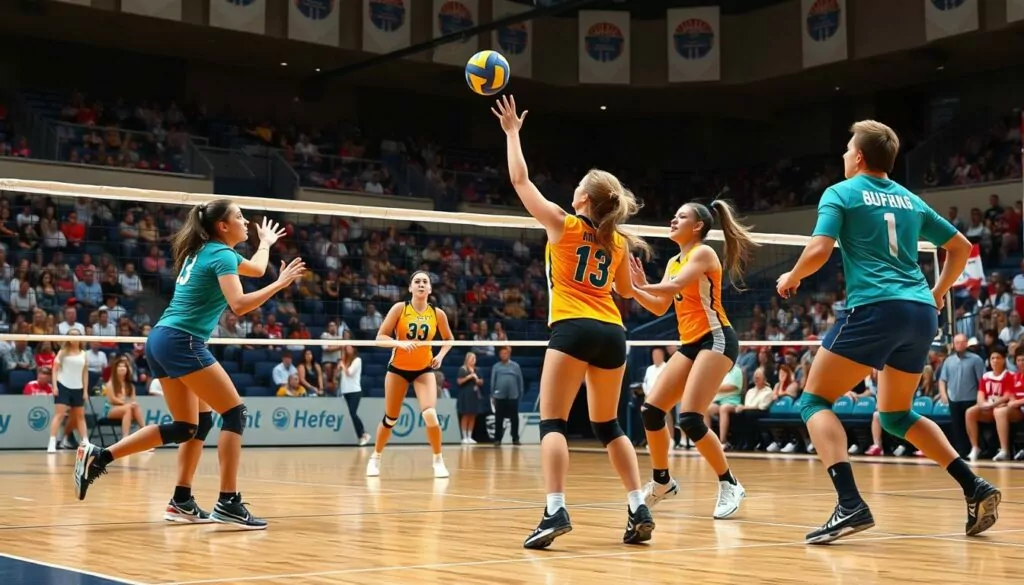
Volleyball is a dynamic sport with different roles for players on the court. These roles help the team work together and perform better. As a volleyball fan, I’m excited to explain the main positions and why they matter.
Overview of Positions
The six main volleyball positions are:
- Setter
- Outside Hitter
- Opposite Hitter
- Middle Blocker
- Libero
- Defensive Specialist
Each role has special skills and strategies. They all work together to make a strong and efficient volleyball team.
Importance of Each Role
The setter is key, setting up teammates for attacks. The outside hitter and opposite hitter score most points. The middle blocker defends the net.
The libero and defensive specialist help defend, making sure the team can return the ball well.
“In volleyball, every position is important, and each player has a unique role to play in the team’s success.”
Knowing what each volleyball team position does is key. It helps in planning strategies, using player skills, and winning games.
Understanding the Court Layout
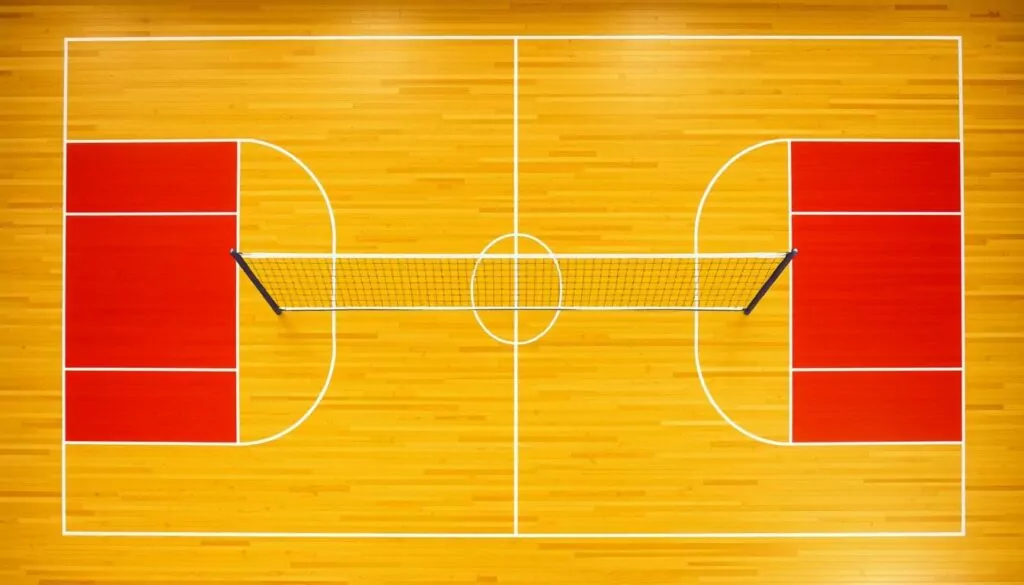
Volleyball is a fast-paced sport that needs players to know their spots on the court. The court is split into six zones, each with its own role. Knowing the court layout helps players play better and follow their team’s plan.
Key Areas of the Court
The court has three front-row and three back-row spots, with players moving clockwise after each point. Important areas include the attack line, sidelines, end lines, and the free zone. These spots guide where players should be during the game.
Positioning During Gameplay
Being in the right place is key to playing well in volleyball. Players need to adjust their spots based on the game’s flow and their team’s strategy. With each player having a role, teams work together better. Understanding the court helps players make smart moves and help their team win.
| Zone | Position | Key Responsibilities |
|---|---|---|
| 1 | Back Row | Passing, Digging, Serving |
| 2 | Outside Hitter | Attacking, Passing, Defending |
| 3 | Middle Blocker | Blocking, Attacking |
| 4 | Outside Hitter | Attacking, Passing, Defending |
| 5 | Back Row | Passing, Digging, Serving |
| 6 | Setter | Setting, Directing Offense |
Knowing the court layout and where to stand is vital for volleyball success. By understanding the court and where players should be, teams can set up strong defenses and attacks. This leads to better gameplay and more wins.
The Six Primary Volleyball Positions
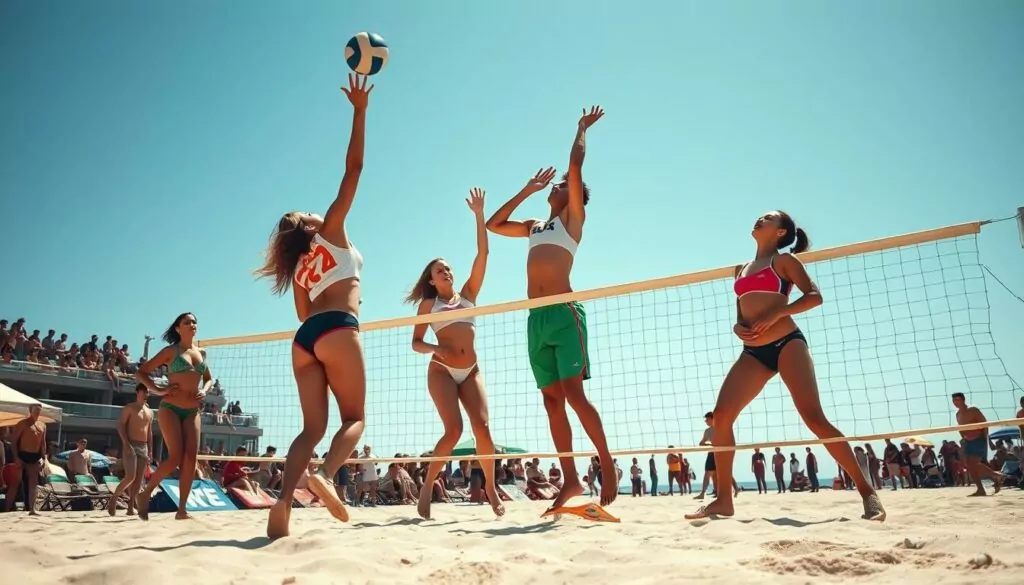
In volleyball, each player has a special role that helps the team win. Let’s explore the six main volleyball positions and what each does.
Setter: The Playmaker
The setter leads the team’s offense, passing the ball to hitters. They have great ball control and make quick decisions. Setters plan the team’s attacks, helping their teammates to succeed.
Their volleyball setter responsibilities include setting up the perfect plays and keeping the game flowing smoothly.
Outside Hitter: The Scorer
Outside hitters are key in the team’s offense. They hit hard, serve well, and help with passing. Their volleyball hitter positions make them top scorers.
Middle Blocker: The Defender
Middle blockers are the team’s main defense. They are usually the tallest players. They block the opponent’s attacks with their power.
They need great timing, jumping ability, and strategy to do well.
Opposite Hitter: The Game Changer
The opposite hitter, or right-side hitter, is a secondary attacker and backup setter. They add to the team’s offense. Their volleyball hitter positions make them game changers.
Each volleyball position is vital for the team’s success. Knowing what each role needs helps players find their place on the team.
Offensive Strategies in Volleyball
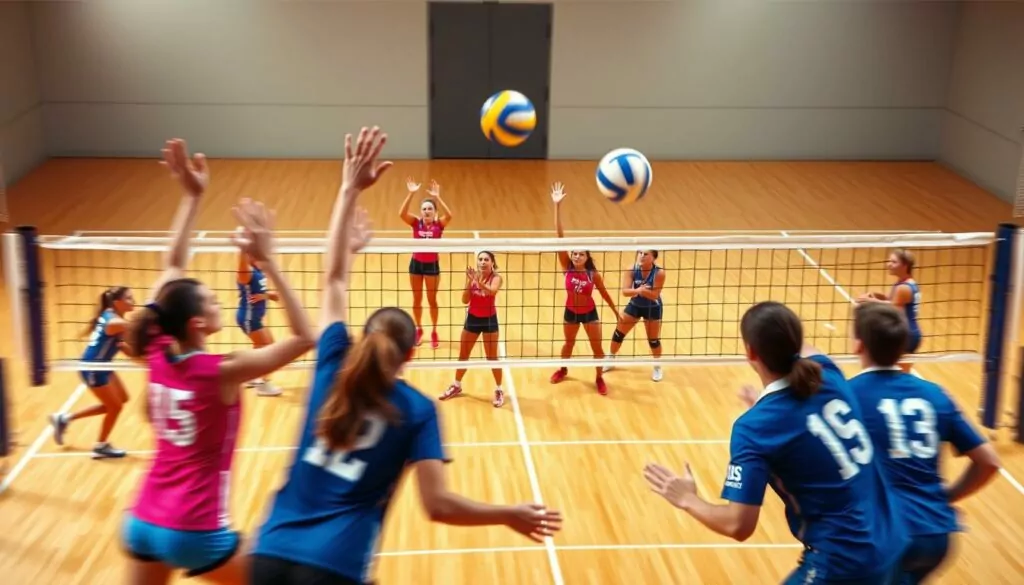
Mastering volleyball offensive strategies is key to beating opponents and winning games. Each player on the court has a vital role in these coordinated attacks.
Role of Each Position in Offense
The setter leads the attack, choosing which hitter to target next. Hitters, like outside and middle blockers, then carry out the plan. The libero helps with accurate passing, setting up successful attacks.
Teams use different formations and quick plays to catch opponents off guard. These tactics highlight each player’s strengths and roles.
Setting Plays and Attacks
Setters use various volleyball setting plays to keep opponents guessing. They set the ball high or low, making it hard for hitters to miss. This decision-making is key to scoring.
Hitters need to be skilled in volleyball offensive strategies. They must spike the ball, redirect it, and vary their attack angles. Good communication and teamwork between setter and hitters are vital for success.
| Offensive Statistic | Desired Performance |
|---|---|
| Kills per Set | 15-16 points |
| Blocks per Set | 1-2 points |
| Aces per Set | 1-2 aces |
| Points Conceded per Set | 6-7 points |
Knowing the volleyball rotation rules helps teams plan effective attacks. This knowledge boosts scoring chances and puts pressure on opponents.
Success in volleyball offensive strategies comes from teamwork. Players must work together, making quick decisions to score and control the game.
Defensive Strategies in Volleyball
In volleyball, having good defensive strategies is key to winning. Players need to know how to position themselves and work together. This can greatly affect the game’s outcome.
Positioning for Successful Defense
The defensive area in volleyball is huge, covering 900 square feet. Players must place themselves wisely to cover this space. They should keep their body ready to react, with their arms between the ball and the floor.
It’s important to position yourself before the attacker hits the ball. This way, you can respond more effectively. Letting the opponent hit the ball over or around the block, but not through, is a good strategy. It helps you understand the opponent’s strengths and your team’s abilities.
Teamwork in Defense
Teamwork and communication are vital for a strong defense in volleyball. Good communication can mean the difference between a successful dig and a missed chance. It helps the team move together smoothly and reduces mistakes.
Knowing how to read the hitters is also key. Anticipating the opponents’ moves helps the team position themselves better. This skill improves with experience and observation, making the defense stronger.
Effective block coverage is another important part of defense. It requires teamwork, quick reactions, and understanding the game. By blocking well, the team can stop easy points for the other team and create chances to attack.
The “digging deep” strategy is also valuable. It involves disrupting the opponent’s rhythm and creating chances for your team. This skill needs control and precision but can be developed with practice.
In conclusion, volleyball defense involves many elements like positioning, teamwork, and specialized skills. By mastering these, players and teams can build a strong defense. This increases their chances of winning.
Specialized Roles within the Team
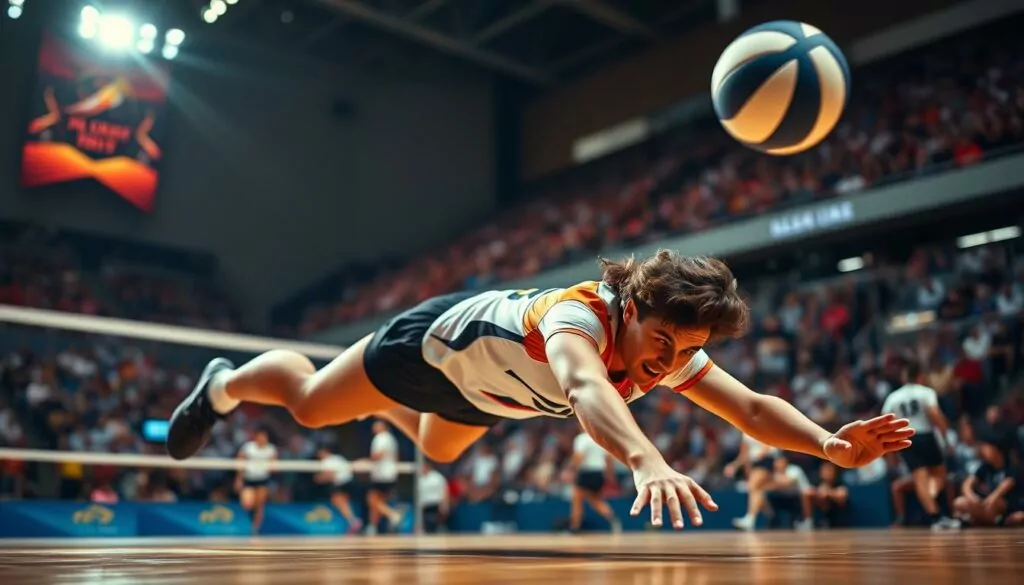
In volleyball, each player has a special role that helps the team win. The libero is a key defensive player who plays a big part in the game.
The Impact of a Libero
The libero can switch places with any back-row player without counting as a substitution. They are known for their great passing, setting, and defense. Liberos are experts at digging and receiving serves, keeping the team’s offense going.
Their skill in reading the game and predicting the opponent’s moves is very important. It helps keep the team’s defense strong.
Understanding the Flow of Play
Knowing the volleyball rotation rules is key for all players. They need to quickly adjust to different game situations. The smooth flow of play comes from each player knowing their role and the team’s strategy.
Setters lead the offense, and middle blockers are ready for quick attacks near the net. When players work together, they can outsmart their opponents and score more.
Being good at volleyball is not just about individual skills. It’s about how those skills work together to make the team strong. By playing to their strengths and working as a team, players can improve their team’s chances of winning.
| Position | Key Responsibilities | Typical Player Attributes |
|---|---|---|
| Libero |
|
|
| Middle Blocker |
|
|
How to Choose the Right Position
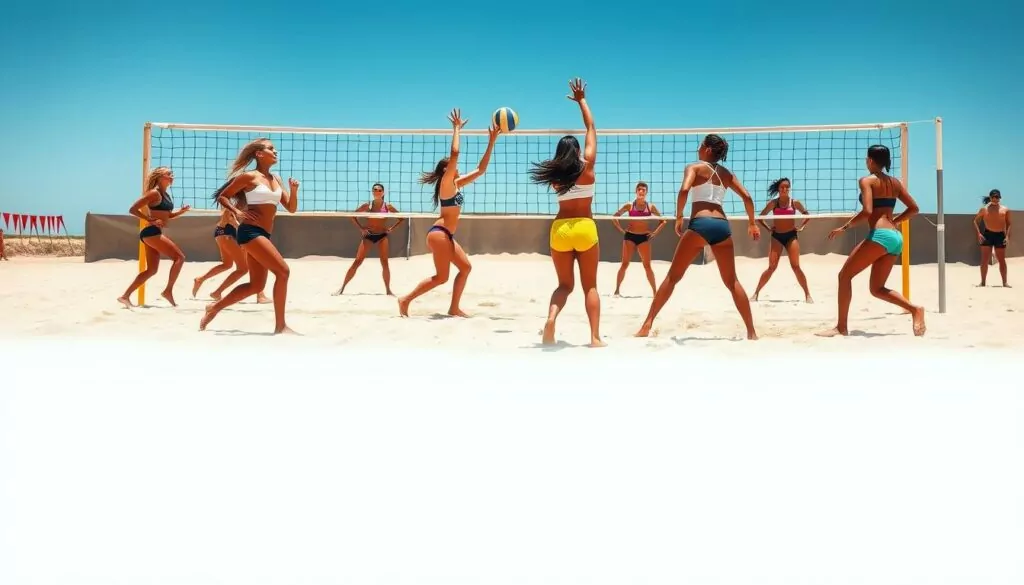
Choosing the right volleyball position is key for both you and your team. It’s important to know your skills and how they match up with each role. This way, you can find your best spot and help your team win.
Assessing Your Skills
First, look at what you’re good at and what you need to work on. Think about your height, how well you can jump, and your ball control. Also, consider your passing skills and how you think strategically. These things will help figure out where you fit best.
Don’t be afraid to try out different roles. You might find you’re really good at something you didn’t think you’d be.
Considering Team Needs
It’s also important to think about what your team needs. Talk to your coach or teammates to learn about the roles that need filling. This way, you can see where your skills can help the team the most.
Volleyball has many positions, like setters, outside hitters, and middle blockers. Each role has its own tasks and needs certain skills. For example, setters are like the team’s leaders, setting the pace and passing the ball. Outside hitters are usually the ones scoring the most, attacking from the left side.
By looking at your skills and what your team needs, you can find the right position for you. Being open to trying new roles can help you grow and improve as a player.
“Finding the right position is not just about your individual skills, but also how you can complement the team’s dynamics and strategy. Be adaptable, listen to your coach, and embrace the opportunity to explore different roles on the court.”
Training Tips for Each Position
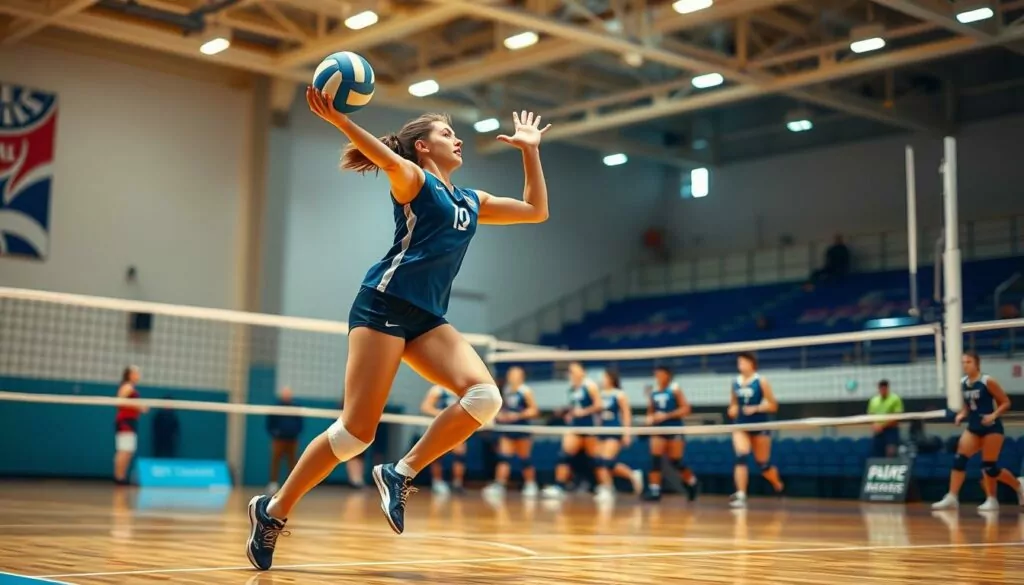
As a passionate volleyball player, I’ve learned that training for your position is key. Whether you’re a setter, hitter, or libero, improving your skills is vital. Here are some tips for each position.
Drills for Setters
As the volleyball setter, you control the ball and lead the offense. Focus on ball control, decision-making, and communication. Practice quick footwork, setting accuracy, and passing drills that mimic game scenarios.
Building a strong connection with hitters through setting practice is essential.
Skills for Hitters
For volleyball hitters, mastering the attack is key. Work on your approach, timing, and shot selection. Practice vertical jump, swing mechanics, and hitting different sets.
Try hitting from various angles and speeds to keep the defense off balance.
Techniques for Liberos
As a libero, your defense is critical. Focus on passing accuracy, defensive positioning, and quick reflexes. Practice low passes, diving, and agility to improve court coverage.
Developing a keen eye for the game will make you invaluable on the back line.
Remember, all players should do general volleyball conditioning. This includes agility drills, footwork patterns, and strength training. A strong physical base will help you perform your skills better.
“The secret to my success? It’s simple – I just focus on honing my craft, one drill at a time. Consistent, position-specific training is the name of the game.”
The journey to mastering your volleyball position is ongoing. Stay committed and watch your game improve. Happy training!
The Importance of Communication on the Court
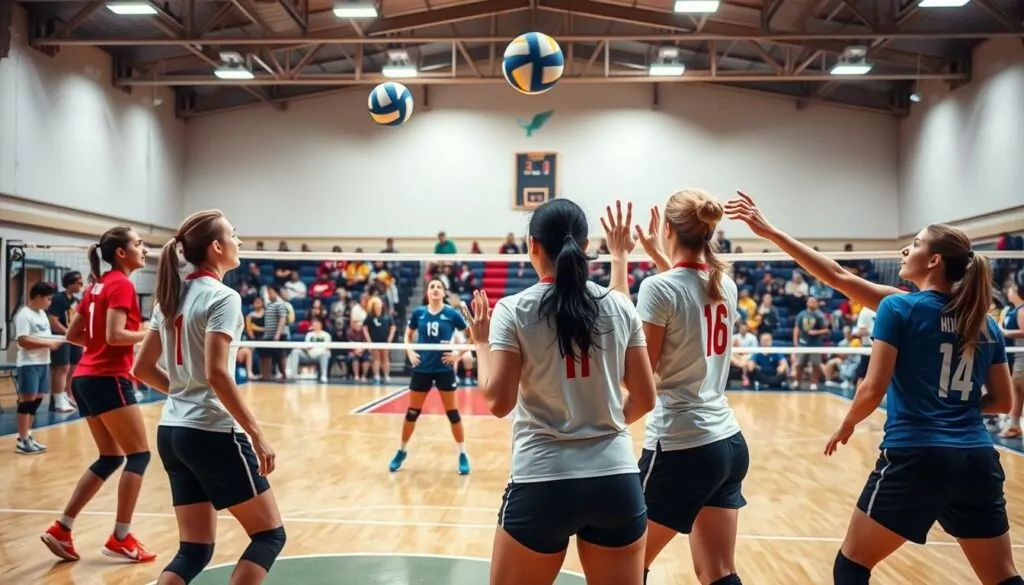
Good communication is key for a winning volleyball team. It helps in planning plays and guessing the other team’s moves. Players like the setter, hitter, and libero use words and signals to work together well.
Verbal Cues and Signals
Before the game, teams study the opponent’s style. They look at their hitting, defense, and offense. During the game, players use words and hand signals to share important info.
For example, the defense might tell the team where the other team’s best hitter is. They also share the setter’s spot and how many hitters are out there.
Building Trust Among Teammates
Good communication is more than just sharing info. It’s about trusting and supporting each other. When players listen well, respect each other, and encourage each other, they work better together.
Staying calm under pressure helps too. It makes communication clearer and the team more united.
Being able to talk well is what makes a volleyball team strong. By talking clearly, players can guess what their teammates will do. This helps them make smart choices and run complex plays smoothly. This leads to a better team.
| Communication Aspect | Description |
|---|---|
| Pre-match | Assessing opponent’s tendencies, focusing on hitting preferences, defensive strategies, and offensive plays |
| Serve/Receive | Specifying court coverage areas, sharing server tendencies, and coordinating offensive setups |
| Defensive Narration | Communicating opponent’s system status, set quality, and planned attacks |
| Offensive Strategy | Communicating readiness to hit, assessing blocking situations, and ensuring complete hitter coverage |
Good communication in volleyball is vital. It helps players guess plays, cut down mistakes, and keep their offense strong. By learning to use words, signals, and listening well, players build trust and improve their team’s game.
Adapting to Different Game Formats
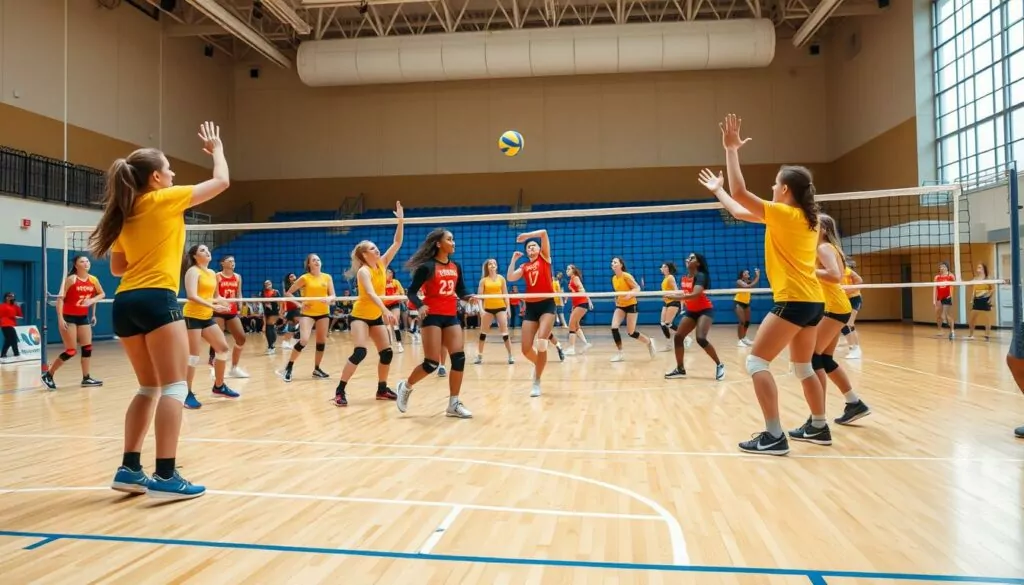
In the sport of volleyball the players have to be able to adapt with different game types. Beach and indoor volleyball share a few fundamentals, however, they also face their distinct difficulties. Players need to be strategic to be successful in both.
Indoor Volleyball Positions
Indoor volleyball teams comprise 6 players each of whom has particular roles. The setter is the primary player in the offense, and the outside hitters are responsible for most percent of points. Middle blockers protect the opposing hitters, while middle blockers are able to play a variety of roles. Liberos concentrate on defense and are an important component to the team’s game plan. Being aware of each position is crucial to win in indoor games.
Beach Volleyball Positions
Beach volleyball is, however there are only two players on each team. Therefore, players need to excel at every aspect from serving to defense. They should take on more ground and be able to handle both defense and offense. In order to play beach volleyball effectively the players need to possess many different skills and be able switch roles quickly.
The transition between indoor and beach volleyball requires a thorough understanding of each sport’s specific requirements. The players must alter strategies, tactics and their decision-making skills to succeed in both. The ability to adapt will lead to more enjoyment and success in this ever-changing game.
| Indoor Volleyball Positions | Beach Volleyball Positions |
|---|---|
| Setter | All-around Player |
| Outside Hitter | All-around Player |
| Middle Blocker | N/A |
| Opposite Hitter | N/A |
| Libero | N/A |
Position-Specific Tips for Success
In volleyball, every player plays an important part in ensuring the success of the team. As a veteran player, I’ve discovered that the ability to master your position is crucial. If your an volleyball player as well as a volleyball player Here are a few suggestions to assist you in shining.
Strategies for Setters
The setter is similar to the quarterback of the team. They must efficiently distribute the ball to players. Be conscious of their game, and making quick choices. Make use of various sets to keep your opponent in the dark.
A good technique for setting is essential. Make sure you practice regularly to develop your ball handling abilities.
Advice for Hitters
The ability to hit is crucial for scoring points. For maximum effectiveness, practice various shots. Make sure you are practicing your timing using the setter, and be ready to tweak your swing.
Being versatile and consistent is crucial for a powerful player.
Best Practices for Liberos
The libero’s focus is on defense, and keeps his ball from the ground. Concentrate on analyzing the opponent’s tactics and perfecting your passing. Keep your head down, speed up and effectively communicate with your teammates.
Learning to study game films and understanding the nature of your opponent is essential. Always strive to improve your game. With these suggestions to improve your performance and aid your team to succeed.
| Position | Key Responsibilities | Essential Skills |
|---|---|---|
| Setter | The orchestrating of the offense, and distributing the ball to players | Court awareness, rapid decision-making, precise ball handling |
| Hitter | Points are scored through effective and flexible attacks | Different shot choices, timing to the settingter flexibility |
| Libero | Assisting in defense as well as receiving attacks and serves | Recognizing the opponent’s tendencies Excellent passing technique |
“The setter is the quarterback of the team, responsible for orchestrating the offense and making quick decisions on the court.”
Common Mistakes to Avoid
Volleyball is a fast-paced sport that requires precision teamwork. Even experienced players make mistakes that can affect their performance. We’ll explore common mistakes such as blocking too much or insufficient communication among teammates.
Overcommitting and Positioning Errors
A major mistake is taking too much time to blocks. The players could jump too early and leave spaces for the team in front. In addition, improper position during rotations could cause players to step on other’s heels.
To address these issues problems, players need to be sure to keep the court clean and are aware of the rules for rotation of volleyball. They must also be aware of their teammates in their position. Exercises, drills and visual exercises will help to improve these skills.
Incorrect communication with teammates
Good communication is key in volleyball. If it isn’t there, the players could take the same ball and not be aware of what colleagues are doing. This can result in mistakes and missed opportunities to score.
To be more effective in communicating players must utilize clear and concise language and signals. Exercises for the team along with volleyball defensive patterns can help teammates feel comfortable and connect with one another more effectively.
Avoiding these errors and improving their communication skills players can enhance their performance. This will help their team win in volleyball.
The Role of Coaches in Position Development
As a highly experienced volleyball coach with more than twenty years experience in the field, I understand how important coaches are. They assist players in their development of positions. It’s not just about assigning roles, it’s an extensive look into the strengths and weaknesses of each player.
How Coaches Guide Players
Coaches evaluate the skills of players and match their abilities to the team’s requirements. They determine the best volleyball role and volleyball positions to ensure the team’s achievement. They provide specific training, mentoring and feedback in order to increase the players’ abilities and understanding of court.
Coaches should also strive to create players who are more flexible. While players must master their primary positions, experimenting with different roles is crucial. This increases the player’s volleyball intelligence and team’s ability to adapt.
Creating a Cohesive Team Strategy
Good coaches understand the importance of position development as a collaborative effort not just a single individual. They study games and create drills that simulate real-game situations. This assists in improving players build trust in the team and increases the flow of play.
The role of a coach goes beyond the technical aspects. This is about creating a culture that encourages improvement, adaptability and collaboration. This requires knowledge, experience and a profound love to play.
“The coach’s primary responsibility is to improve the team’s overall level and individual player performance, not just recruit players.”
Over 20 years of coaching experience, I’ve witnessed how coaching can transform a team’s or player’s game. Through this approach coaches can assist players achieve their full potential as volleyball players.
My Journey Through Volleyball Positions
My experience across different volleyball roles was thrilling and educational. I began as a middle hitter, and currently play libero. Every position has distinct requirements and responsibility.
Finding My Fit
I was attracted by mid-middle hitter from the beginning. I loved blocking my opponent’s attacks. However, my obsession shifted to defense when I got older.
Lessons Learned Along the Way
The switch to libero was a huge game changer for me. I was taught about anticipation, rapid reaction times and cooperation. Being in the back row and receiving serve became an opportunity to be proud.
I also earned respect for the other roles. The role of the setter in leading the offense, as well as the scoring abilities of the outside hitter are both impressive. Playing in different positions has helped me become an improved player and increased my knowledge regarding the game.
Learning to master every role is a challenging and rewarding task. I’m looking forward to what’s to come in this exciting sport.
